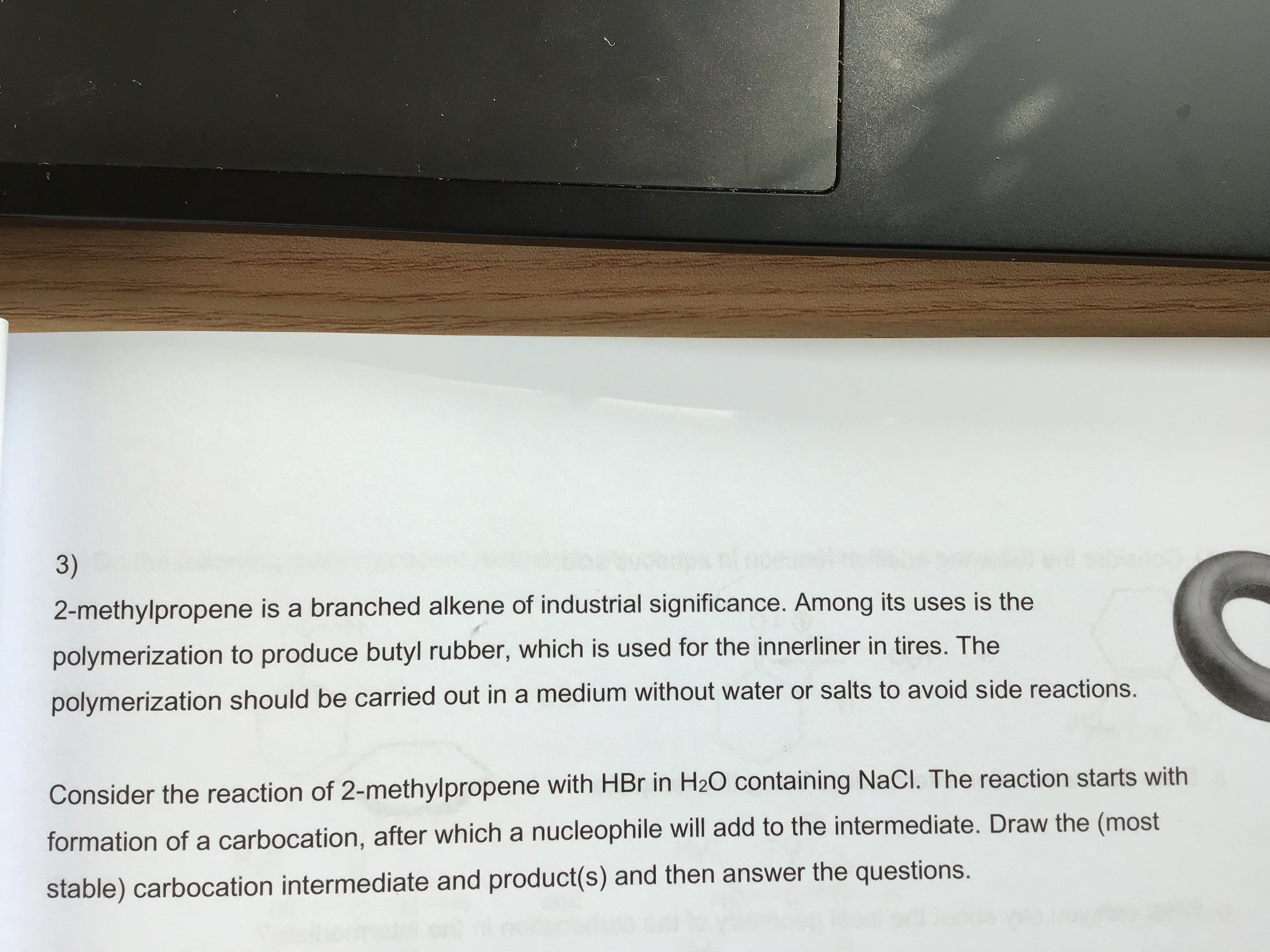Consider the reaction of 2-methylpropene with HBr in H2O containing NaCl. The reaction starts with formation of a carbocation, after which a nucleophile will add to the intermediat... Consider the reaction of 2-methylpropene with HBr in H2O containing NaCl. The reaction starts with formation of a carbocation, after which a nucleophile will add to the intermediate. Draw the (most stable) carbocation intermediate and product(s).

Understand the Problem
The question describes a reaction involving 2-methylpropene with HBr in the presence of water and NaCl. It asks you to draw the most stable carbocation intermediate and the final product(s) of this reaction. This requires understanding carbocation stability and nucleophilic addition reactions.
Answer
Carbocation Intermediate: $$ \begin{array}{c} \phantom{CH_3}CH_3 \\ \phantom{CH_3}|\phantom{CH_3}\\ CH_3 - C^+ - CH_3 \end{array} $$ Product: 2-methylpropan-2-ol $$ \begin{array}{c} \phantom{CH_3}CH_3 \\ \phantom{CH_3}|\phantom{CH_3}\\ CH_3 - C - CH_3 \\ \phantom{CH_3}| \\ \phantom{CH_3}OH \end{array} $$
Answer for screen readers
Carbocation Intermediate: $$ \begin{array}{c} \phantom{CH_3}CH_3 \ \phantom{CH_3}|\phantom{CH_3}\ CH_3 - C^+ - CH_3 \end{array} $$
Product: 2-methylpropan-2-ol $$ \begin{array}{c} \phantom{CH_3}CH_3 \ \phantom{CH_3}|\phantom{CH_3}\ CH_3 - C - CH_3 \ \phantom{CH_3}| \ \phantom{CH_3}OH \end{array} $$
Steps to Solve
- Draw 2-methylpropene
Draw the structure of 2-methylpropene.
- Protonation of the alkene
The $HBr$ will protonate the double bond of 2-methylpropene. Since the reaction mentions forming the most stable carbocation intermediate, it's important to consider where the proton will add. The most stable carbocation will be formed on the more substituted carbon i.e. the carbon with two methyl groups attached. This is because a tertiary carbocation is more stable than a primary carbocation due to hyperconjugation and inductive effects.
- Draw the carbocation intermediate
Draw the structure of the carbocation formed after protonation. The positive charge will be on the carbon atom bonded to two methyl groups, making it a tertiary carbocation.
- Identify the nucleophiles
The reaction is carried out in the presence of $H_2O$ and $NaCl$. This means the available nucleophiles are $H_2O$, $Cl^-$, and $Br^-$. Since water is the solvent, it is present in a much higher concentration than the other nucleophiles. Thus, water is the more likely nucleophile to attack the carbocation.
- Draw the product of nucleophilic attack
Water ($H_2O$) will attack the carbocation, forming an oxonium ion. Subsequently, another water molecule will deprotonate the oxonium ion, yielding an alcohol.
- Draw the final product(s)
Draw the structure of the alcohol formed after the water molecule attacks the carbocation and is deprotonated. Write the chemical name of the product.
Carbocation Intermediate: $$ \begin{array}{c} \phantom{CH_3}CH_3 \ \phantom{CH_3}|\phantom{CH_3}\ CH_3 - C^+ - CH_3 \end{array} $$
Product: 2-methylpropan-2-ol $$ \begin{array}{c} \phantom{CH_3}CH_3 \ \phantom{CH_3}|\phantom{CH_3}\ CH_3 - C - CH_3 \ \phantom{CH_3}| \ \phantom{CH_3}OH \end{array} $$
More Information
The reaction follows Markovnikov's rule, where the hydrogen adds to the carbon with more hydrogens, and the nucleophile adds to the more substituted carbon, leading to the more stable carbocation intermediate and final product.
Tips
A common mistake is to form the less stable primary carbocation. It is crucial to consider carbocation stability and form the more stable tertiary carbocation. Another mistake could be not recognizing that water is the main nucleophile in this reaction, as it is the solvent, and incorrectly adding $Cl^-$ or $Br^-$ instead.
AI-generated content may contain errors. Please verify critical information